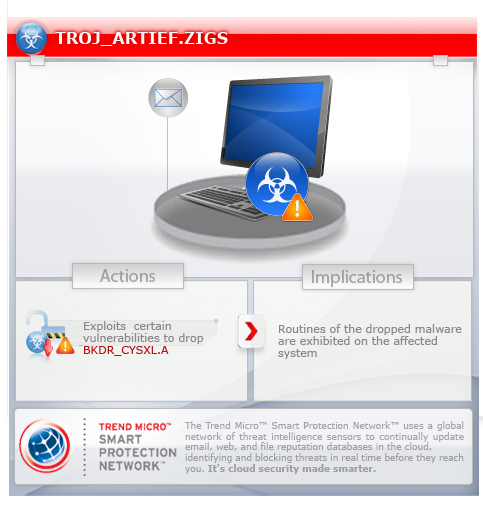TROJ_ARTIEF.ZIGS
Windows 2000, Windows XP, Windows Server 2003


Threat Type: Trojan
Destructiveness: No
Encrypted: Yes
In the wild: Yes
OVERVIEW
Via email
This Microsoft Word document malware uses social engineering methods to lure users into performing certain actions that may, directly or indirectly, cause malicious routines to be performed. Specifically, it makes use of North Korea rocket launch to lure users into opening itself.
To get a one-glance comprehensive view of the behavior of this Trojan, refer to the Threat Diagram shown below.

This Trojan arrives as an attachment to email messages spammed by other malware/grayware or malicious users.
It executes the dropped file(s). As a result, malicious routines of the dropped files are exhibited on the affected system.
TECHNICAL DETAILS
154,555 bytes
RTF
20 Apr 2012
Drops files
Arrival Details
This Trojan arrives as an attachment to email messages spammed by other malware/grayware or malicious users.
Installation
This Trojan drops the following non-malicious file:
- %User Temp%\London 2012.doc
(Note: %User Temp% is the current user's Temp folder, which is usually C:\Documents and Settings\{user name}\Local Settings\Temp on Windows 2000, XP, and Server 2003.)
Dropping Routine
This Trojan drops the following files:
- %System Root%\Document and Settings\All users\realupdate.exe - detected as BKDR_CYSXL.A
(Note: %System Root% is the root folder, which is usually C:\. It is also where the operating system is located.)
It takes advantage of the following software vulnerabilities to drop malicious files:
It executes the dropped file(s). As a result, malicious routines of the dropped files are exhibited on the affected system.
NOTES:
Upon execution, it opens its dropped non-malicious file, %User Temp%\London 2012.doc, to hide its malicious routines from the user.
(Note: %User Temp% is the current user's Temp folder, which is usually C:\Documents and Settings\{user name}\Local Settings\Temp on Windows 2000, XP, and Server 2003.. %Temp% is the Windows Temporary folder, which is usually C:\Windows\Temp or C:\WINNT\Temp.)
SOLUTION
9.200
8.925.01
20 Apr 2012
8.927.00
21 Apr 2012
Step 1
For Windows XP and Windows Server 2003 users, before doing any scans, please make sure you disable System Restore to allow full scanning of your computer.
Step 3
Search and delete this file
- %User Temp%\London 2012.doc
Step 4
Scan your computer with your Trend Micro product to delete files detected as TROJ_ARTIEF.ZIGS. If the detected files have already been cleaned, deleted, or quarantined by your Trend Micro product, no further step is required. You may opt to simply delete the quarantined files. Please check this Knowledge Base page for more information.
Step 5
Download and apply these security patches Refrain from using these products until the appropriate patches have been installed. Trend Micro advises users to download critical patches upon release by vendors.
Did this description help? Tell us how we did.


